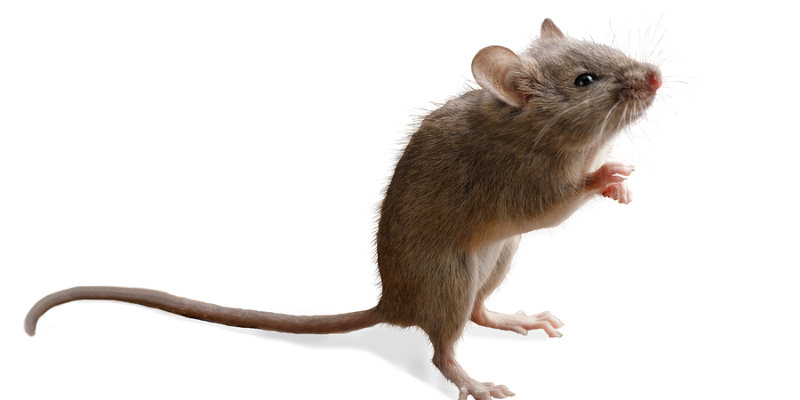Mice range in size from 5 to 7 inches (13 to 18 cm) long (including a long tail). They weigh from 1/4 to 2 ounces (7 to 57 gm). The coat color ranges from white to brown to gray. Most mice have a pointed snout with long whiskers, round ears, and thin tails. Many mice scurry along the ground, but some can hop or jump.

- A mouse (plural mice) is a small animal that belongs to one of numerous species of rodents. The best known mouse species is the common house mouse (Mus musculus). It is found in nearly all countries and, as the laboratory mouse, serves as an model organism in biology. It is also a popular pet. The American white-footed mouse (Peromyscus leucopus) and the deer mouse (Peromyscus maniculatus) also sometimes live in houses. These species of mice live commensally with humans.
- Although mice may live up to two years in the lab, the average mouse in the wild lives only about 5 months, primarily due to heavy predation. Cats, wild dogs, foxes, birds of prey, snakes and even certain kinds of insects have been known to prey heavily upon mice. Nevertheless, due to its remarkable adaptability to almost any environment, and its ability to live commensally with humans, the mouse is regarded to be the third most successful mammalian species living on Earth today, after humans and the rat.
- Mice can be harmful pests, damaging and eating crops and spreading diseases through their parasites and feces. In western North America, breathing dust that has come in contact with mouse feces has been linked to the deadly hantavirus. The original motivation for the domestication of cats is thought to have been for their predation of mice and their relatives, the rats.
- Mice have been known to humans since antiquity. The Romans differentiated poorly between mice and rats, calling rats Mus Maximus (big mouse) and referring to mice as Mus Minimus (little mouse). In Spanish similar terms are in use: ratón for mouse and rata for rat.
- De-coloration in mice was supposedly first noticed in China by 1100 BC, where a white mouse was discovered. However, there is sufficient evidence to believe that white mice were first noticed before that.
- The word “mouse” and the word muscle are related. Muscle stems from musculus meaning small mouse – possibly because of a similarity in shape. The word “mouse” is a cognate of Sanskrit mus meaning ‘to steal,’ which is also cognate with mys in Old Greek and mus in Latin.
- All species of Mus are native to Eurasia and Africa, where they range from lowlands to mountaintops. The five species in the subgenus Pyromys are found in Sri Lanka, India, and mainland Southeast Asia. Much of their range originally consisted of open grasslands or grassy patches in forests.
- Mice are timid, social, and territorial. They are usually active in the night time, while others, such as the harvest mouse, are active both day and night.
- Baby mice just a day old
- Breeding onset is at about 50 days of age in both females and males, although females may have their first estrus at 25-40 days. Mice are polyestrous and breed year round; ovulation is spontaneous. The duration of the estrous cycle is 4-5 days and estrus itself lasts about 12 hours, occurring in the evening. Vaginal smears are useful in timed matings to determine the stage of the estrous cycle. Mating is usually nocturnal and may be confirmed by the presence of a copulatory plug in the vagina up to 24 hours post-copulation. The presence of sperm on a vaginal smear is also a reliable indicator of mating.
- Female mice housed together tend to go into anestrus and do not cycle. If exposed to a male mouse or the pheromones of a male mouse, most of the females will go into estrus in about 72 hours. This synchronization of the estrous cycle is known as the Whitten effect. The exposure of a recently bred mouse to the pheromones of a strange male mouse may prevent implantation (or pseudopregnancy), a phenomenon known as the Bruce effect.
- The average gestation period is 20 days. A fertile postpartum estrus occurs 14-24 hours following parturition, and simultaneous lactation and gestation prolongs gestation 3-10 days due to delayed implantation. The average litter size is 10-12 during optimum production, but is highly strain dependent. As a general rule, inbred mice tend to have longer gestation periods and smaller litters than outbred and hybrid mice. The young are called pups and weigh 0.5-1.5 grams at birth, are hairless, and have closed eyelids and ears. Cannibalism is uncommon, but females should not be disturbed during parturition and for at least 2 days postpartum. Pups are weaned at 3 weeks of age; weaning weight is 10-12 grams. If the postpartum estrus is not utilized, the female resumes cycling 2-5 days postweaning.
- Newborn male mice are distinguished from newborn females by noting the greater anogenital distance and larger genial papilla in the male. This is best accomplished by lifting the tails of litter mates and comparing perineums.
At Longhorn Termite & Pest Control, we offer mouse control services for customers in Azle, Weatherford, Benbrook, and Graham, Texas.
